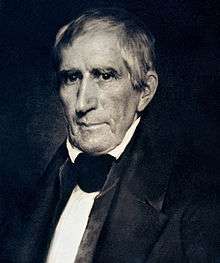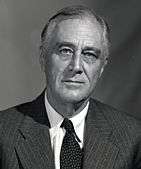List of Presidents of the United States by time in office
|
|
 William Henry Harrison Shortest presidency 31 days 1841 |
This is a list of Presidents of the United States by time in office. The basis of the list is the difference between dates; if counted by number of calendar days all the figures would be one greater, with the exception of Grover Cleveland who would receive two days.
Since 1789, there have been 43 people sworn into office as President of the United States, and 44 presidencies, as Grover Cleveland served two non-consecutive terms and is counted chronologically as both the 22nd and 24th president. Of the individuals elected as president, four (William Henry Harrison,[1] Zachary Taylor,[2] Warren G. Harding,[3] and Franklin D. Roosevelt) died in office of natural causes, four (Abraham Lincoln,[4] James A. Garfield,[4][5] William McKinley,[6] and John F. Kennedy) were assassinated, and one (Richard Nixon[7]) resigned.
William Henry Harrison spent the shortest time in office, and Franklin D. Roosevelt spent the longest. He is the only president to have served more than two terms. At the present time (since the presidency of Dwight Eisenhower) the United States Constitution limits the number of times an individual can be elected president.
Presidents by time in office
| Rank | President | Length in days | Order of presidency | General details |
|---|---|---|---|---|
| 1 | Franklin D. Roosevelt | 4,422[lower-alpha 1] | 32 | Served three full terms. Died 2 months and 24 days into his fourth term. |
| 2 tie | Thomas Jefferson | 2,922 | 3 | Served two full terms. |
| James Madison | 2,922 | 4 | Served two full terms. | |
| James Monroe | 2,922 | 5 | Served two full terms. | |
| Andrew Jackson | 2,922 | 7 | Served two full terms. | |
| Ulysses S. Grant | 2,922 | 18 | Served two full terms. Did not seek reelection in 1876. In 1880, he sought but did not win renomination. | |
| Grover Cleveland | 2,922 | 22/24 | Served two full terms; non-consecutively. | |
| Woodrow Wilson | 2,922 | 28 | Served two full terms. | |
| Dwight D. Eisenhower | 2,922 | 34 | Served two full terms. | |
| Ronald Reagan | 2,922 | 40 | Served two full terms. | |
| Bill Clinton | 2,922[lower-alpha 2] | 42 | Served two full terms. | |
| George W. Bush | 2,922 | 43 | Served two full terms. | |
| 13 | Barack Obama | 2,878 | 44 | Incumbent, serving his second term of office. |
| 14 | George Washington | 2,865[lower-alpha 3] | 1 | Served two full terms. |
| 15 | Harry S. Truman | 2,840 | 33 | Served the remaining 3 years, 9 months and 8 days of Franklin Roosevelt's fourth term. Served a full term. Withdrew from the race for renomination.[lower-alpha 4] |
| 16 | Theodore Roosevelt | 2,728 | 26 | Served the remaining 3 years, 5 months and 18 days of McKinley's second term. Served a full term. Did not seek reelection in 1908. In 1912, he was defeated for another term as president. |
| 17 | Calvin Coolidge | 2,041 | 30 | Served the remaining 1 year, 7 months and 2 days of Harding's term. Served a full term. Did not seek renomination. |
| 18 | Richard Nixon | 2,027 | 37 | Served one full term. Resigned 1 year, 6 months and 20 days into his second term. |
| 19 | Lyndon B. Johnson | 1,886 | 36 | Served the remaining 1 year, 1 month and 29 days of Kennedy's term. Served a full term. Withdrew from the race for renomination. |
| 20 | William McKinley | 1,654[lower-alpha 2] | 25 | Served one full term. Assassinated 6 months and 2 days into his second term, dying 8 days later, 6 months and 10 days into that term. |
| 21 | Abraham Lincoln | 1,503 | 16 | Served one full term. Assassinated 1 month and 11 days into his second term. |
| 22 tie | John Quincy Adams | 1,461 | 6 | Served one full term. Not re-elected. |
| Martin Van Buren | 1,461 | 8 | Served one full term. Not re-elected. | |
| James K. Polk | 1,461 | 11 | Served one full term. Did not seek a second term. | |
| Franklin Pierce | 1,461 | 14 | Served one full term. Not renominated. | |
| James Buchanan | 1,461 | 15 | Served one full term. Did not seek a second term. | |
| Rutherford B. Hayes | 1,461 | 19 | Served one full term. Did not seek a second term. | |
| Benjamin Harrison | 1,461 | 23 | Served one full term. Not re-elected. | |
| William Howard Taft | 1,461 | 27 | Served one full term. Not re-elected. | |
| Herbert Hoover | 1,461 | 31 | Served one full term. Not re-elected. | |
| Jimmy Carter | 1,461 | 39 | Served one full term. Not re-elected. | |
| George H. W. Bush | 1,461 | 41 | Served one full term. Not re-elected. | |
| 33 | John Adams | 1,460[lower-alpha 2] | 2 | Served one full term. Not re-elected. |
| 34 | John Tyler | 1,430 | 10 | Served the remaining 3 years and 11 months of William H. Harrison's term. Not nominated. |
| 35 | Andrew Johnson | 1,419 | 17 | Served the remaining 3 years, 10 months and 17 days of Lincoln's second term. Not nominated. |
| 36 | Chester A. Arthur | 1,262 | 21 | Served the remaining 3 years, 5 months and 13 days of Garfield's term. Not nominated. |
| 37 | John F. Kennedy | 1,036 | 35 | Assassinated 2 years, 10 months and 2 days into his term. |
| 38 | Millard Fillmore | 969 | 13 | Served the remaining 2 years, 7 months and 23 days of Taylor's term. Not nominated. |
| 39 | Gerald R. Ford | 895 | 38 | Served the remaining 2 years, 5 months and 11 days of Nixon's second term. Not elected to a full term. |
| 40 | Warren G. Harding | 881 | 29 | Died 2 years, 4 months and 29 days into his term. |
| 41 | Zachary Taylor | 492 | 12 | Died 1 year, 4 months and 5 days into his term. |
| 42 | James A. Garfield | 199 | 20 | Assassinated 3 months and 28 days after taking office, dying 79 days later, 6 months and 15 days into his term. |
| 43 | William Henry Harrison | 31 | 9 | Died 1 month into his term. |
Notes
- ↑ The 20th Amendment (ratified in 1933) moved Inauguration Day from March 4 to January 20. The 1937 presidential inauguration was the first to take place on the new date. As a result, Franklin Roosevelt's first term in office (1933–1937) was only 1,418 days long, 1 month and 12 days shorter than a normal term.
- 1 2 3 Of years evenly divisible by 100, only those evenly divisible by 400 are leap years. The years 1800 and 1900 are divisible by 100, but not by 400. Thus, John Adams's term and McKinley's first term did not include a 366-day leap year, so those terms were one day shorter than a normal full term. The year 2000 is divisible by 400 and so did include one, thus Clinton's second term was not shorter than his first.
- ↑ Due to logistical delays, Washington's first inauguration was held 1 month and 26 days after the scheduled start of operations of the new government under the Constitution of the United States. As a result, his first term was only 1,404 days long, and was the shortest term for a U.S. president who neither died in office nor resigned.
- ↑ The 22nd Amendment (ratified in 1951) made a president ineligible for election to a third term or for election to a second full term after serving more than two remaining years of a term of a previously elected president. The latter clause would have applied to Truman's situation in 1952 except that a grandfather clause in the amendment explicitly excluded the amendment from applying to the incumbent president.
References
- ↑ Cleaves, Freeman (1939). Old Tippecanoe: William Henry Harrison and His Time. C. Scribner's Sons. p. 152.
- ↑ Ingersoll, Jared. "Death of the President". University of Virginia's Miller Center of Public Affairs. Retrieved November 2, 2010.
- ↑ Russell, Francis (1962). The Shadow of Blooming Grove – Warren G. Harding in His Times. Easton Press. p. 591. ISBN 0070543380.
- 1 2 Martin, Paul "Lincoln's Missing Bodyguard", Smithsonian Magazine, April 8, 2010, Retrieved November 15, 2010
- ↑ Donald (1996), p. 597.
- ↑ "Big Ben Parker and President McKinley's Assassination". Math.buffalo.edu. Retrieved August 8, 2011.
- ↑ "Nixon Resigns". The Washington Post. Retrieved December 31, 2008.
External links
| Wikimedia Commons has media related to President of the United States. |
